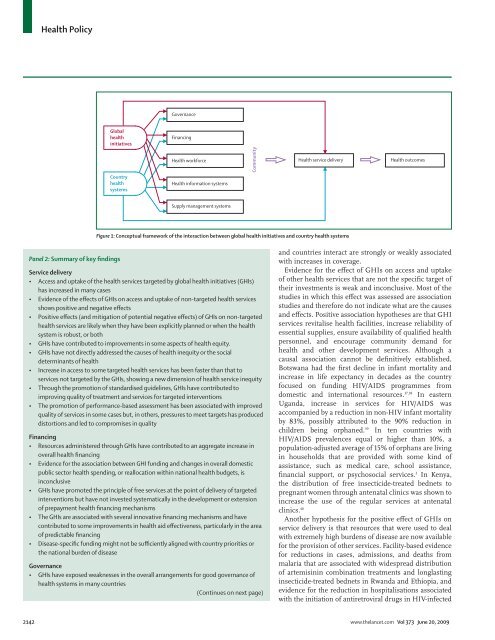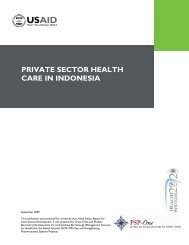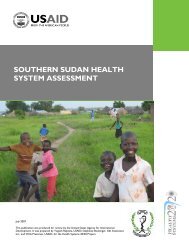An assessment of interactions between global ... - ResearchGate
An assessment of interactions between global ... - ResearchGate
An assessment of interactions between global ... - ResearchGate
You also want an ePaper? Increase the reach of your titles
YUMPU automatically turns print PDFs into web optimized ePapers that Google loves.
Health Policy<br />
Governance<br />
Global<br />
health<br />
initiatives<br />
Financing<br />
Country<br />
health<br />
systems<br />
Health workforce<br />
Health information systems<br />
Community<br />
Health service delivery<br />
Health outcomes<br />
Supply management systems<br />
Figure 1: Conceptual framework <strong>of</strong> the interaction <strong>between</strong> <strong>global</strong> health initiatives and country health systems<br />
Panel 2: Summary <strong>of</strong> key findings<br />
Service delivery<br />
• Access and uptake <strong>of</strong> the health services targeted by <strong>global</strong> health initiatives (GHIs)<br />
has increased in many cases<br />
• Evidence <strong>of</strong> the effects <strong>of</strong> GHIs on access and uptake <strong>of</strong> non-targeted health services<br />
shows positive and negative effects<br />
• Positive effects (and mitigation <strong>of</strong> potential negative effects) <strong>of</strong> GHIs on non-targeted<br />
health services are likely when they have been explicitly planned or when the health<br />
system is robust, or both<br />
• GHIs have contributed to improvements in some aspects <strong>of</strong> health equity.<br />
• GHIs have not directly addressed the causes <strong>of</strong> health inequity or the social<br />
determinants <strong>of</strong> health<br />
• Increase in access to some targeted health services has been faster than that to<br />
services not targeted by the GHIs, showing a new dimension <strong>of</strong> health service inequity<br />
• Through the promotion <strong>of</strong> standardised guidelines, GHIs have contributed to<br />
improving quality <strong>of</strong> treatment and services for targeted interventions<br />
• The promotion <strong>of</strong> performance-based <strong>assessment</strong> has been associated with improved<br />
quality <strong>of</strong> services in some cases but, in others, pressures to meet targets has produced<br />
distortions and led to compromises in quality<br />
Financing<br />
• Resources administered through GHIs have contributed to an aggregate increase in<br />
overall health financing<br />
• Evidence for the association <strong>between</strong> GHI funding and changes in overall domestic<br />
public sector health spending, or reallocation within national health budgets, is<br />
inconclusive<br />
• GHIs have promoted the principle <strong>of</strong> free services at the point <strong>of</strong> delivery <strong>of</strong> targeted<br />
interventions but have not invested systematically in the development or extension<br />
<strong>of</strong> prepayment health financing mechanisms<br />
• The GHIs are associated with several innovative financing mechanisms and have<br />
contributed to some improvements in health aid effectiveness, particularly in the area<br />
<strong>of</strong> predictable financing<br />
• Disease-specific funding might not be sufficiently aligned with country priorities or<br />
the national burden <strong>of</strong> disease<br />
Governance<br />
• GHIs have exposed weaknesses in the overall arrangements for good governance <strong>of</strong><br />
health systems in many countries<br />
(Continues on next page)<br />
and countries interact are strongly or weakly associated<br />
with increases in coverage.<br />
Evidence for the effect <strong>of</strong> GHIs on access and uptake<br />
<strong>of</strong> other health services that are not the specific target <strong>of</strong><br />
their investments is weak and inconclusive. Most <strong>of</strong> the<br />
studies in which this effect was assessed are association<br />
studies and therefore do not indicate what are the causes<br />
and effects. Positive association hypotheses are that GHI<br />
services revitalise health facilities, increase reliability <strong>of</strong><br />
essential supplies, ensure availability <strong>of</strong> qualified health<br />
personnel, and encourage community demand for<br />
health and other development services. Although a<br />
causal association cannot be definitively established,<br />
Botswana had the first decline in infant mortality and<br />
increase in life expectancy in decades as the country<br />
focused on funding HIV/AIDS programmes from<br />
domestic and international resources. 37,38 In eastern<br />
Uganda, increase in services for HIV/AIDS was<br />
accompanied by a reduction in non-HIV infant mortality<br />
by 83%, possibly attributed to the 90% reduction in<br />
children being orphaned. 39 In ten countries with<br />
HIV/AIDS prevalences equal or higher than 10%, a<br />
population-adjusted average <strong>of</strong> 15% <strong>of</strong> orphans are living<br />
in households that are provided with some kind <strong>of</strong><br />
assistance, such as medical care, school assistance,<br />
financial support, or psychosocial services. 2 In Kenya,<br />
the distribution <strong>of</strong> free insecticide-treated bednets to<br />
pregnant women through antenatal clinics was shown to<br />
increase the use <strong>of</strong> the regular services at antenatal<br />
clinics. 40<br />
<strong>An</strong>other hypothesis for the positive effect <strong>of</strong> GHIs on<br />
service delivery is that resources that were used to deal<br />
with extremely high burdens <strong>of</strong> disease are now available<br />
for the provision <strong>of</strong> other services. Facility-based evidence<br />
for reductions in cases, admissions, and deaths from<br />
malaria that are associated with widespread distribution<br />
<strong>of</strong> artemisinin combination treatments and longlasting<br />
insecticide-treated bednets in Rwanda and Ethiopia, and<br />
evidence for the reduction in hospitalisations associated<br />
with the initiation <strong>of</strong> antiretroviral drugs in HIV-infected<br />
2142 www.thelancet.com Vol 373 June 20, 2009
















